#st patricks day food
Explore tagged Tumblr posts
Text
#enchiladas#food mashup#corned beef and cabbage#st patricks day food#swiss cheese#cornstarch#wheat tortillas#caraway seeds
3 notes
·
View notes
Text

(source)
797 notes
·
View notes
Text

#green#St. Patrick's Day#st. patty's day#Irish#4 leaf clover#CLOVER#pastel#pastel aesthetic#Aesthetic#food#cooking#baking#sweet#dessert#delicious#tea#teapot#Tea Party#teaset#st.paddy's day#cookies
617 notes
·
View notes
Photo

Guinness beef stew
#stew#beef stew#mashed potatoes#beef#food#irish stew#guinness#potatoes#peas#comfort food#dinner#meal#st patricks day#cabbage#foodporn#delicious#cooking#food photography#foodgasm#recipe
4K notes
·
View notes
Text
Food on St Patrick's Day (in the USA)...
...is usually Corned Beef & Cabbage, which is the Irish-American version of the original Irish boiled bacon & cabbage, but while the celebratory Irishness is still going strong, try something a bit more authentic.
A nice warm coddle. Not cuddle, coddle, though just as comforting in its own way. (Some sources suggest it's a hangover cure, not that such a thing would ever be necessary at this time of year, oh dear me no.)
Coddle is a stew using potatoes, onions, bacon, sausages, stout-if-desired / stock-if-not, pepper, sage, thyme and Time.
You'll often see it called "Dublin Coddle", but my Mum made Lisburn Coddle lots of times, I've made West Wicklow Coddle more than once, and on one occasion in a Belgian holiday apartment I made Brugsekoddel, which is an OK spelling for something that doesn't exist in any cookbook.
*****
I do remember one amendment I made to Mum's recipe, which met with slight resistance at the time and great appreciation thereafter.
Her coddle was originally cooked on the stove-top, not in the oven, and nothing was pre-cooked. Potatoes were quartered, onions were sliced, bacon was cut into chunks and then everything went into the big iron casserole, then onto the slow back ring, and there it simmered Until Done.
However, the bacon was thick-cut back rashers, and the sausages were pork chipolatas.
Raw, they looked like this:
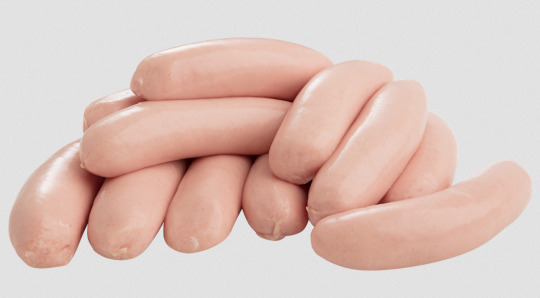
...and the bacon looked like this:

Cooked in the way Mum initially did, they looked pretty much the same afterwards. The sausages didn't change colour. Nor did the bacon.
While everything tasted fine, the meat parts always looked - to me, anyway - somewhat ... less than appealing. "Surgical appliance pink" is the kindest way to put it, and that's all I'm saying. This is apparently "white coddle" and Dubs can get quite defensive about This Is The Way It SHOULD Look.
I'm not a Dub, so I persuaded Mum to fry both the bacon and sausages first, just enough to get a bit of brown on, and wow! Improvement! I remember my Dad nodding in approval but - because he was Wise - not saying anything aloud until Mum gave it the green light as well.
Doing the coddle in the oven, first with lid on then with lid off, came later and met with equal approval. So did using only half of the onion raw and frying the other half lightly golden in the bacon fat.
Nobody quoted from a movie that wouldn't be made for another decade, but there was a definite feeling of...

*****
There are coddle recipes all over the Net: I've made sure that these are from Ireland to avoid the corned-beef-not-boiled-bacon "adjustment" versions which are definitely out there. I've already seen one with Bratwurst. Just wait, it'll be chorizo next.
Oh, hell's teeth, I was right. And from RTE...
Returning to relative normality, here's Donal Skehan's white coddle and his browned coddle with barley (I'm going to try that one).
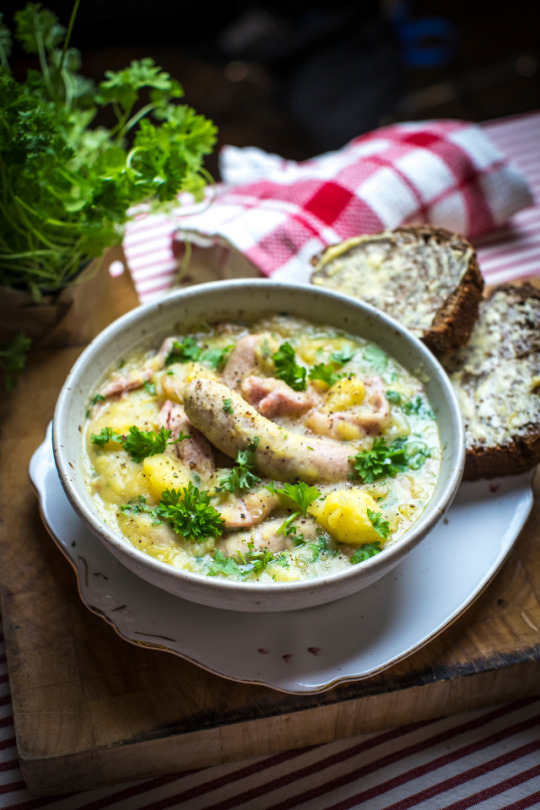

Here's Dairina Allen's Frenchified with US measurements version. (I feel considerably less heretical now.)
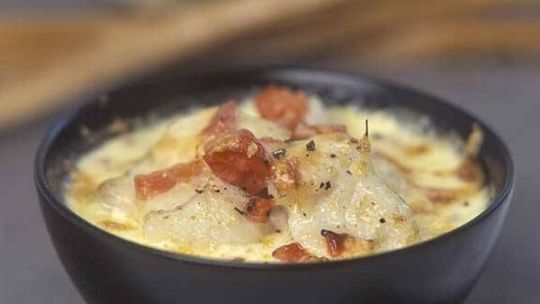
And finally (OK, not Irish, but it references a couple of the previous ones and is a VERY comprehensive write-up, so gets a pass) Felicity Cloake's Perfect Dublin Coddle (perfect according to who, exactly...?) in The Guardian.
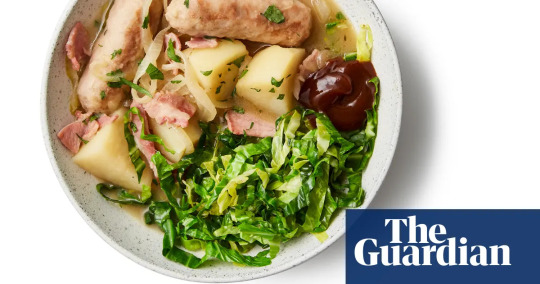
*****
Returning to the beginning, and how boiled bacon became corned beef (a question which prompted @dduane to start an entire website...!)
The traditional Irish meat animal for those who could afford it was the pig, but when Irish immigrants (even before the Great Famine) arrived in the USA, they often lived in the same urban districts as Jewish immigrants from Eastern Europe.
For fairly obvious reasons pork, bacon and other piggy products were unavailable in those districts, but salt beef was right there and far cheaper than any meat Irish immigrants had ever seen before.
Insist on tradition or eat what was easy to find? There'd have been contest - and do I sometimes wonder a bit if sauerkraut ever came close to replacing cabbage for the same reason.
The pre-Famine Irish palate liked sour tastes: a German (?) visitor to Ireland in the mid-1600s wrote about about what were called "the best-favoured peasantry in Europe", and mentioned that they had "seventy-several sour milks and creams*, and the sourer they be, the better they like them."
* Yogurt? Kefir? Skyr? Gosh...
Corned beef and Kraut as the immigrants' celebratory "Irish" meal for St Patrick's Day? Maybe, maybe not.
Time for "Immigrant Song" (with kittens).
youtube
*****
Corned beef got its name from the size of the salt grains with which the beef was prepared. They were usually bigger than kosher salt, like pinhead oats or even as large as grains of wheat, and their name derived originally from "corned (gun)powder", the large coarse grains used in cannon.
BTW, "corn" has been a generic English term for "grain" for centuries, and "but Europe didn't have corn" is an American mistake assuming the word refers to sweetcorn / maize, which it doesn't.
Lindsey Davis, author of the "Falco" series, had a couple of rants about it and other US-requested "corrections". As she points out, mistakes need corrected but "corn" is not a mistake, just a difference in vocabulary.
*****
In Ancient and Medieval Ireland pig would have included wild boar, the hunting of which was a suitable pastime for warriors and heroes, because Mr Boar took a very dim view of the whole proceeding and wasn't shy about showing it (see "wild boar" in my tags and learn more).
Cattle were for milk, butter, cream and little cattle; also wealth, status, and heroic displays in their theft, defence or recovery. It's no accident that THE great Irish epic is "The Cattle-Raid of Cooley" / Táin Bó Cúailnge (tawn / toyn boh cool-nyah).
Killing a cow for meat was ostentation on a level of lighting cigars with 100-, or even 500-, currency-unit notes. Once it had been cooked and eaten there'd be no more milk, butter, cream or little cattle from that source, so eating beef was showing off And Then Some.
Also, loaning a prize bull to run with someone else's heifers was a sign of great friendship or alliance, while refusing it might be an excuse for enmity or even war. IMO that's what Maeve of Connaught intended all along, picking undiplomatic envoys who would get drunk and shoot their mouths off so the loan was refused and she, insulted, would have an excuse to...
But I digress, as usual. Or again. Or still... :->
*****
For the most part, "pig" mean "domestic porker", and in later periods right up to the Famine, these animals were seldom eaten.
Instead, known as "the gentleman who pays the rent", the family pig ate kitchen scraps and rooted about for other foods, none of which the tenant had to grow or buy for them. These fattened pigs would go to market twice a year, and the money from their sale would literally pay that half-year's rent.
For wealthier (less poor?) farmers, pigs had another advantage. Calves arrived singly, lambs might be a pair, but piglets popped out by the dozen. A sow with (some of) her farrow was even commemorated on the old ha'penny coin...

What with bulls, chickens, hares, horses, hounds, pigs, salmon and stags, the pre-decimal Irish coinage is a good inspiration for some sort of fantasy currency.
But that's another post, for another day.
#food and drink#St Patrick's Day#Irish cuisine#Dublin coddle#corned beef or boiled bacon#pigs and cattle in Ireland#The Cattle Raid of Cooley#Youtube
561 notes
·
View notes
Text

🌸 Kawaii Shop 🌸
#food#cute food#st patricks day#st paddys day#kawaii#kawaiicore#kawaii blog#kawaii aesthetic#cutecore#cute blog#cute aesthetic#cute#lucky charms
208 notes
·
View notes
Text
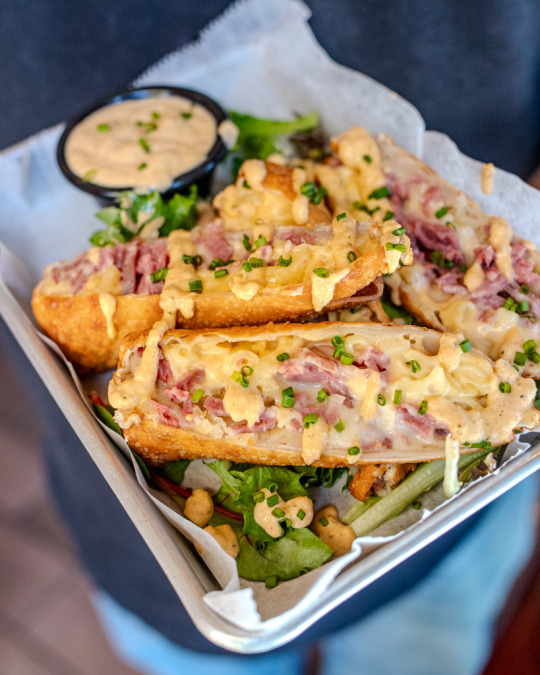
Reuben Mac & Cheese Egg Rolls | Boston Burger Company
#food#cooking#reuben#corned beef#mac and cheese#egg rolls#irish#st patricks day#uotd#whitefireprincess
153 notes
·
View notes
Text
The Jewish mark on iconic Irish cuisine:
Corned Beef and Cabbage is a popular dish among Americans on St. Patricks Day. Traditionally, in Ireland, cabbage was and is paired with pork bacon.
However, during the 19th century, as Irish immigrants moved to the U.S., they discovered there was a lower-cost meat alternative to pork. It was their Jewish neighbors who introduced the cured meat and Kosher butchers to the community when they noticed some similarities in the two salty meats. Cooking the corned beef together with cabbage proved to be a low-cost and delicious solution; and the rest is history.
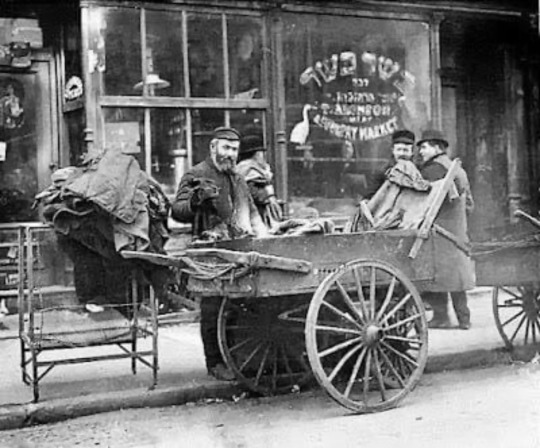
#irish#Irish antisemitism#antisemitism#israel#secular-jew#jewish#judaism#israeli#jerusalem#diaspora#secular jew#secularjew#islam#corned beef and cabbage#corned beef#cabbage#jewish history#lower East side#cuisine#food#Irish food#Irish cuisine#st patricks day#st pattys day
105 notes
·
View notes
Photo
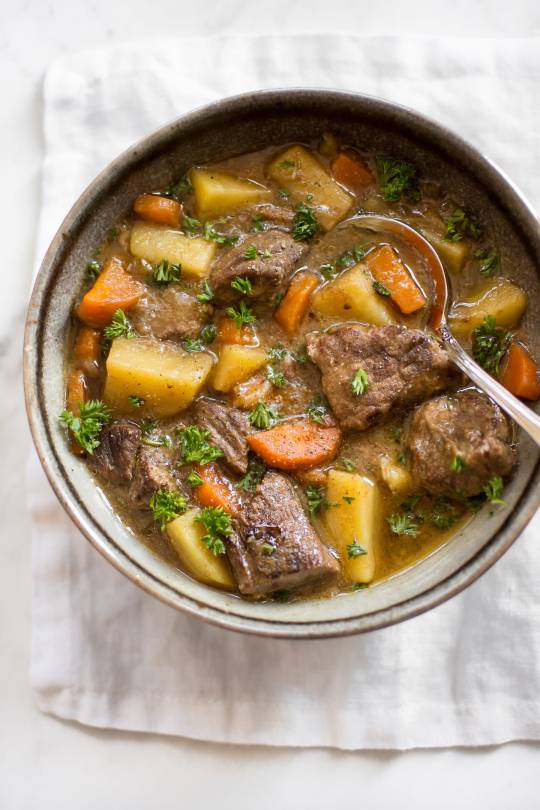
Instant Pot Irish Stew • Salt & Lavender
90 notes
·
View notes
Text
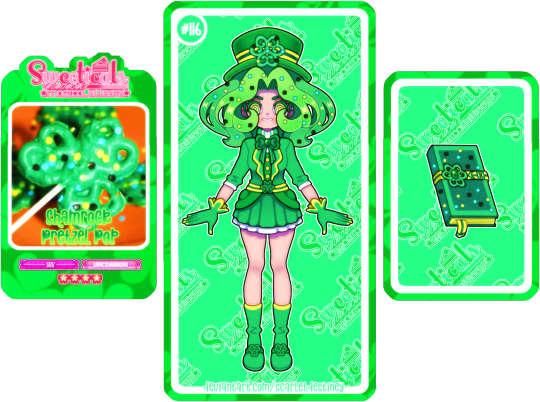
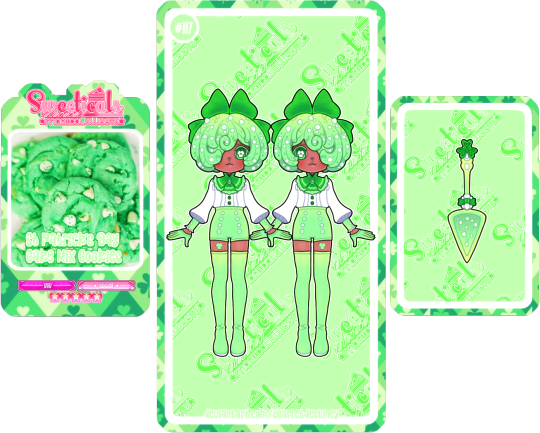
*:・゚✧*:・゚✧ Shamrock Pretzel Pop! (owned by thebattycryptid) And St. Patrick's Day Cake Mix Cookies! (owned by Timshel) Part of our Recent St. Patrick's Week Adopt Batch on discord ~ *:・゚✧*:・゚✧ [ Commissions | DA | IG | Twitter | Redbubble ]
#sweeticals#sweetical#cute#kawaii#aesthetic#humanized#humanization#cs#closed species#design character#scarletdestiney#food gijinka#gijinka#personification#precious bb#magical girl#mahou shoujo#st patrick's day#shamrock
81 notes
·
View notes
Photo

Lucky Charms Cookies
#recipe#cookies#st patricks day recipe#st patricks day#lucky charms#lucky charms marshmallows#lucky charms cookies#cereal#marshmallows#food#dessert#sweets
544 notes
·
View notes
Text
0 notes
Text

source
261 notes
·
View notes
Text

#green#St. Patrick's Day#st. patty's day#Irish#rainbow#pot of gold#pastel#pastel aesthetic#Aesthetic#food#cooking#baking#sweet#dessert#delicious#cake#cupcakes#st.paddy's day
229 notes
·
View notes
Text

Lucky charms cookies
#cookies#sugar cookies#st patricks day#dessert#food#baking#lucky charms#frosted cookies#frosted sugar cookies#frosting#sweet food#sweet#sweets#tasty#foodporn#delicious#cooking#food photography#foodgasm#recipe
233 notes
·
View notes
Video
youtube
One for St Patrick’s Day, also a recipe for any day when you don’t have any bread and want some really soon.
Best eaten with a generous spread of salted butter, Irish if you can get it (Dylan doesn’t do this, he has a thinness to maintain) or used to chase the last toothsome dregs of Irish Stew, Dublin Coddle, Strong Farmer’s Soup - or indeed stuff from outside Ireland such as chilli, goulash, Sauerbraten and any other tasty savoury thing whose last toothsome dregs need chased...
It makes washing the plates so much easier. ;->
Normally at this point I’d link to my Mum’s 4-or-maybe-5-generation-old recipe on European Cuisines, but the site’s not back up yet.
Instead this link goes to Sotsil’s Wordpress page, which not only gives full credit (Yay!) but adds some fun extra observations, including various ways to improvise buttermilk if you can’t find the real thing.
Here it is.
Here’s a pic of the last time we made it:
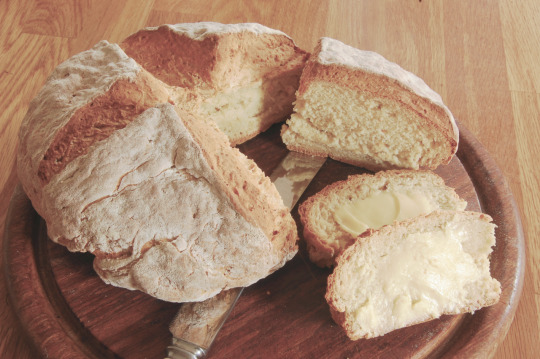
That photo, Dylan’s video and Sotsil’s page all show the oven-baked “cake” version more associated with the South. The North, where I come from, uses the same ingredients and method, but cooks with a skillet / griddle on the stovetop.
That version looks like this:
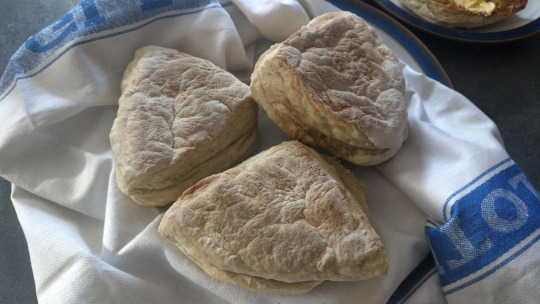
Here it is with the traditional “wee cup of tea”.
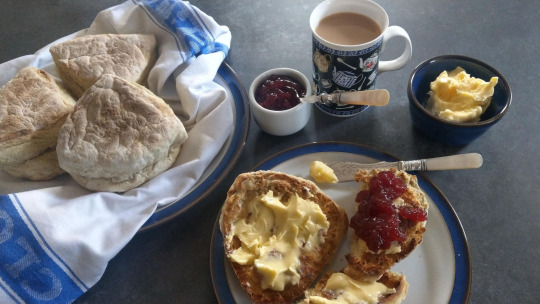
Remember how I said something about butter? Jam, too.
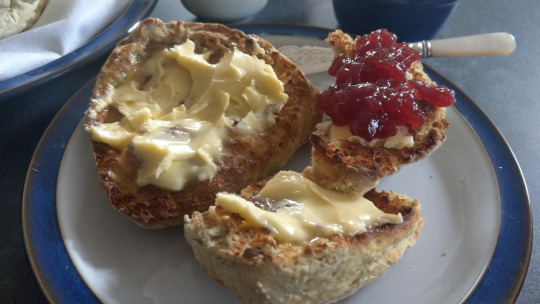
Either warm from the griddle or after being split and toasted, the butter does A Trick, and melts down into the bread. This was the way my Dad liked it.
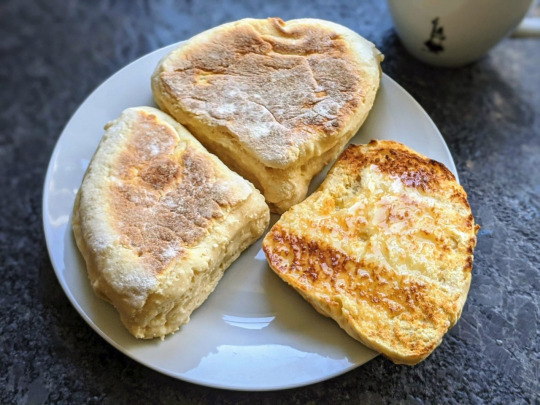
The melted butter of course makes room for more butter, if you like butter (Dad did) though biting into it after that can be an adventure.
If you can manage a slice of street pizza without getting grease on your chin elbows, you’re halfway there already...
1K notes
·
View notes